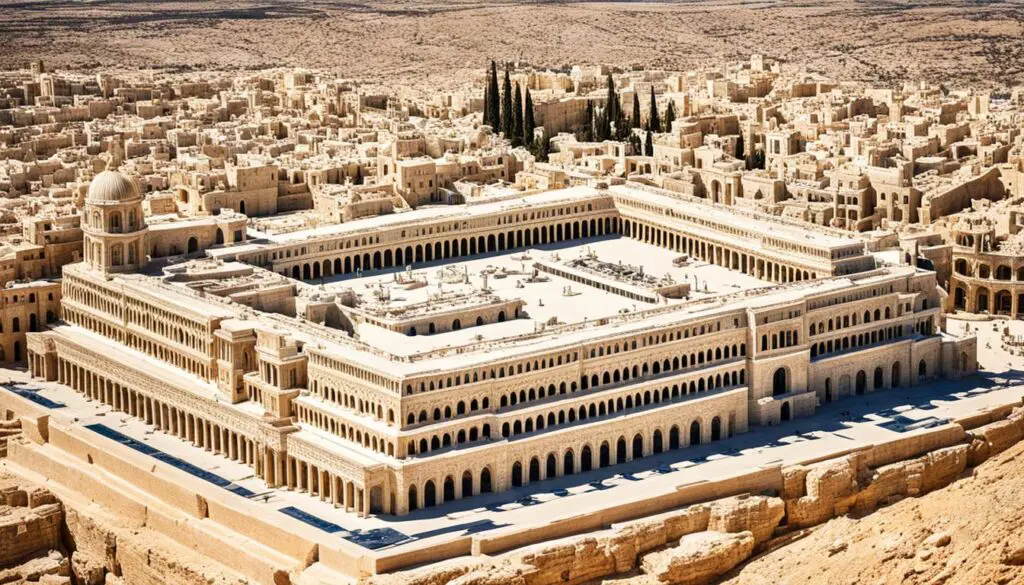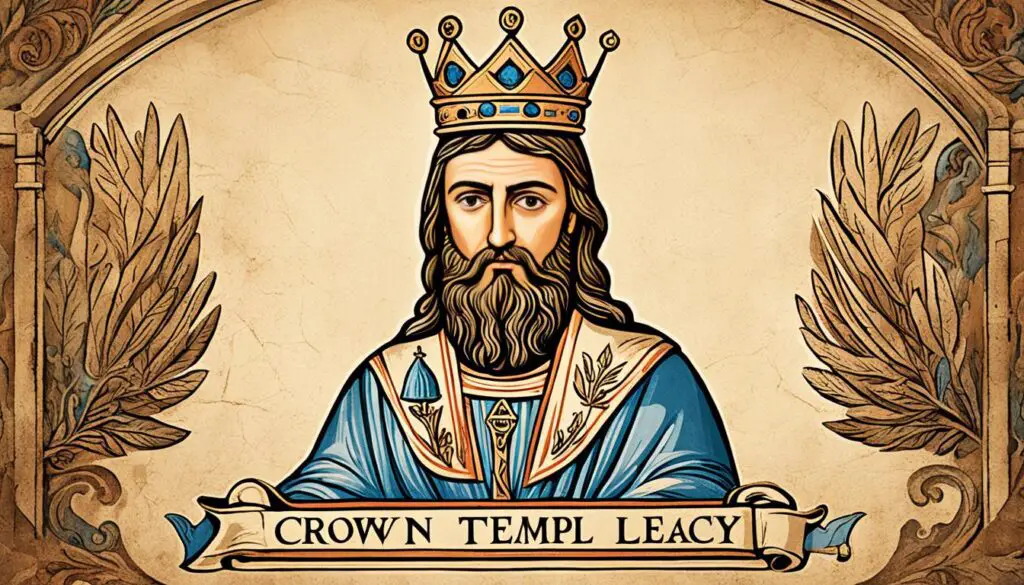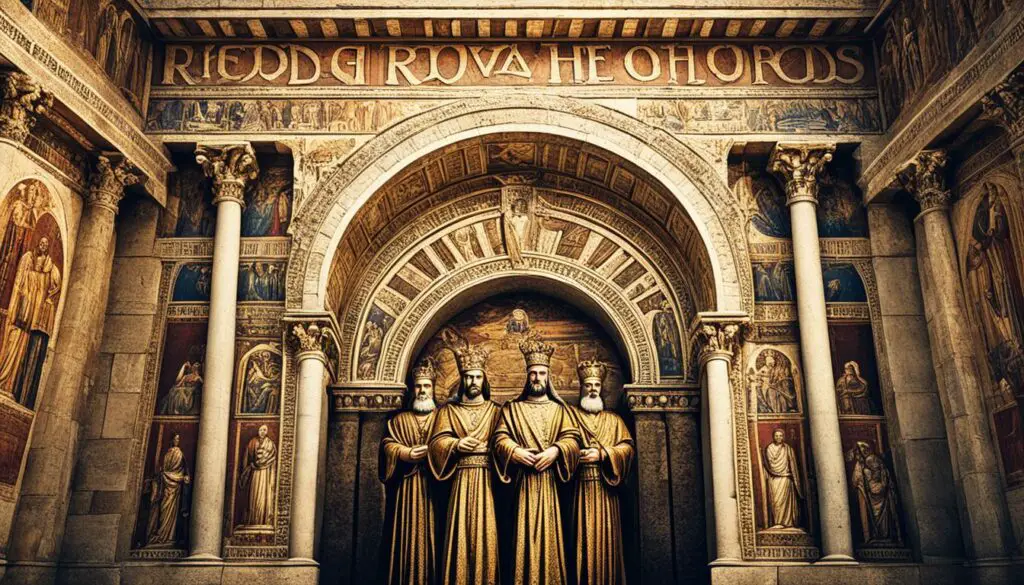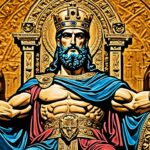Welcome to our exploration of King Herod Philip’s biblical legacy. In the pages of the Bible, we encounter the figure of Herod Philip, also known as Philip the Tetrarch, who played a significant role in the New Testament. From his rule to his interactions with other biblical figures, Herod Philip’s story is intertwined with the events and teachings that have shaped the Christian faith.
In the pages of the Bible, we find stories and accounts that mention Herod Philip. His name surfaces in relation to the arrival of the Magi, the massacre of the innocents, and other pivotal moments in the New Testament. The historical context and actions of King Herod Philip provide important insights into the biblical narrative and the lives of those who played a part in it.
Key Takeaways:
- King Herod Philip, also known as Philip the Tetrarch, is a prominent biblical figure mentioned in the New Testament.
- His rule over Iturea and Trachonitis was marked by attempts to secure power and please both the Romans and the Jewish people.
- Herod Philip’s interactions and rivalry with his half-brother, Herod Antipas, are recounted in the Gospel accounts.
- He engaged in various building projects, contributing to the development of the region during the New Testament era.
- Herod Philip’s legacy remains a subject of debate among historians and theologians, with differing evaluations of his character and actions.
King Herod and His Rule
King Herod, a formidable ruler of Judea appointed by the Romans, played a pivotal role in maintaining peace and upholding Roman authority in the region. His rule laid the foundation for a stable political climate during a critical time in history. After his reign, his son King Herod Philip inherited his father’s position, taking charge of Iturea and Trachonitis. His rule was marked by a delicate balance between securing his power and appeasing both the Romans and the Jewish people.
During his reign, King Herod Philip faced the challenge of navigating through the complexities of Roman rule and religious expectations. To maintain control and stability, he strategically implemented policies and initiatives that aimed to consolidate his power while fostering a harmonious relationship between the ruling forces and his subjects.
“The ruler’s ability to navigate the intricate web of political dynamics during this time made King Herod Philip a prominent figure in the historical context of the region.” – Renowned Historian
King Herod Philip’s reign witnessed the collaboration and tension between imperial influence and local traditions. As a ruler, he delicately balanced the expectations of the Romans, who sought stability and loyalty, with the needs and demands of the Jewish people, who held deep religious and cultural sentiments. The ability to negotiate this delicate balance reflected his skillful leadership and dedication to maintaining peace and order.
Historical Context: A Tumultuous Era
To understand the significance of King Herod Philip’s rule, it is important to acknowledge the historical backdrop against which he governed. The region of Judea, including Iturea and Trachonitis, was under Roman occupation, and the tension between the occupied Jewish territories and the occupying power shaped the political landscape of the time.
At the same time, King Herod Philip’s rule coincided with the advent of a new religious movement that would later become known as Christianity. The influence of these events and figures from the New Testament significantly impacted the reign of King Herod Philip, shaping the narrative of his rule and his interactions with both local subjects and foreign powers.
| Key Points | King Herod and His Rule |
|---|---|
| Reigning Territory | Iturea and Trachonitis |
| Ruling Philosophy | Securing power and pleasing both Romans and Jewish people |
| Political Context | Roman occupation and tension with occupied Jewish territories |
| Historical Significance | Maintaining peace and upholding Roman authority in the region |
Herod Philip’s Role in the New Testament
Herod Philip, an important biblical figure, is mentioned in several accounts in the New Testament. His presence and actions during significant events provide valuable insights into the narrative and teachings of the Bible.
“Now after Jesus was born in Bethlehem of Judea in the days of Herod the king, behold, wise men from the East came to Jerusalem.”
In the Gospel accounts, Herod Philip is associated with the arrival of the Magi in Jerusalem, marking the beginning of a momentous journey to witness the birth of Jesus. As part of his role as ruler over Iturea and Trachonitis, Herod Philip’s domain played a crucial role in these biblical stories.
“Then Herod, when he saw that he was deceived by the wise men, was exceedingly angry; and he sent forth and put to death all the male children who were in Bethlehem and in all its districts, from two years old and under, according to the time which he had determined from the wise men.”
Additionally, Herod Philip’s involvement can be found in the chilling account of the massacre of the innocents. His authority and actions in this tragic event underscore the profound impact he had on the lives of the people during that time.
By studying the Gospel accounts, we gain a deeper understanding of Herod Philip’s character and his role in the New Testament’s biblical events. It enables us to appreciate the historical context in which these stories unfold and the significance of Herod Philip’s presence in shaping the narrative.

Herod Philip’s Relationship with Herod Antipas
Herod Philip, a prominent biblical figure, shared a complex relationship with his half-brother, Herod Antipas. As rulers with their own territories, they held considerable influence in the region. The Gospel accounts mention their interactions and rivalry, providing valuable insights into the dynamics between these biblical figures.
“I have heard about the conflicts and tensions between Herod Philip and Herod Antipas. Their rivalry was evident, as both sought to maintain power and influence over their respective domains.” – Matthew 14:3
Being siblings, Herod Philip and Herod Antipas had a shared history that contributed to their complex relationship. Their competition for control and authority often resulted in strained interactions. As both rulers played significant roles in biblical events, studying their relationship unveils the intricate dynamics of power and politics during that time.
The Sibling Rivalry
The rivalry between Herod Philip and Herod Antipas stemmed from their shared heritage and ambitions. While Herod Philip ruled over Iturea and Trachonitis, Herod Antipas governed Galilee and Perea. The boundaries between their territories often blurred, leading to disputes and power struggles.
- Land disputes: Both brothers claimed rights to certain territories, resulting in conflicts over jurisdiction and control.
- Influence competition: Herod Philip and Herod Antipas vied for the favor of the Romans, seeking to strengthen their positions and gain more power in the region.
- Religious tensions: The brothers also competed for influence among the Jewish population, which played a crucial role in maintaining their rule and authority.
Despite their sibling rivalry, Herod Philip and Herod Antipas continued to navigate their complex relationship, often relying on strategic alliances and political maneuvering to achieve their objectives.

Herod Philip’s Building Projects
Similar to his father, King Herod Philip also had a vision for improving the region’s infrastructure and enhancing the cities under his rule. He embarked on various ambitious building projects that contributed to the development and progress of the New Testament context.
One of Herod Philip’s notable endeavors was the construction of magnificent palaces that showcased his wealth and power. These palaces not only served as extravagant residences but also became symbols of prestige and authority in the region.
Furthermore, Herod Philip focused on fortifying strategic locations with the construction of impressive fortresses. These fortified structures not only ensured the security of his territories but also provided a sense of protection and stability for the local population.
In addition to palaces and fortresses, Herod Philip’s building projects included the establishment of new cities or the enhancement of existing ones. These urban centers served as hubs for commerce, administration, and cultural exchange, propelling the region’s growth and prosperity.

The table below provides a glimpse into some of the notable building projects undertaken by Herod Philip during the New Testament era.
| Project | Location | Purpose |
|---|---|---|
| Herod Philip’s Palace | Bethsaida | Residence and symbol of authority |
| Gaulanitis Fortress | Golan Heights | Strategic defense and security |
| Paneas | Banias, Israel | Cultural and religious center |
| Julias | Julias, Israel | Economic and administrative hub |
These building projects, initiated by Herod Philip, left a lasting impact on the New Testament context. They not only transformed the physical landscape but also played a significant role in shaping the socio-economic and cultural fabric of the region during that era.
Herod Philip’s Legacy and Historical Evaluation
Herod Philip’s legacy continues to be a topic of extensive discussion among historians and theologians. His rule and actions have shaped the perception of him as a controversial figure throughout history. When evaluating his character and impact, contrasting viewpoints emerge, reflecting the complexity of his historical evaluation.
Some critics portray Herod Philip as a cruel and oppressive ruler, emphasizing his involvement in the events described in the New Testament. They argue that his actions, such as the massacre of the innocents, exemplify his brutal nature and disregard for human life.
Conversely, proponents of a more nuanced historical evaluation propose that Herod Philip played a cautious role in maintaining stability and serving the interests of the Roman Empire. They argue that his allegiance to Rome helped prevent uprisings in his territories and ensured a peaceful coexistence between the Jews and the Roman authority.
Understanding Herod Philip’s legacy requires a comprehensive analysis of both perspectives. This evaluation is crucial not only in deciphering his impact on biblical events but also in unraveling the historical context of the New Testament.
“Herod Philip’s legacy encapsulates the complexity of his rule and the multifaceted nature of his impact on the region. Evaluating his character and actions sheds light on the intermingling dynamics of power, political intrigue, and religious tensions during that time.”
Regardless of the divergent opinions, Herod Philip’s role in biblical narratives and the historical context of the New Testament offers a rich tapestry to explore. By delving into the historical evaluation of this controversial figure, we gain valuable insights into the complexities of the era and the profound influence it had on subsequent events.

Herod Philip’s Impact on New Testament Figures and Events
Herod Philip, a prominent biblical figure, played a significant role in shaping the lives and experiences of various New Testament figures. His rule and decisions had far-reaching impacts on both individuals and historical events during that time.
Influencing John the Baptist
One of the notable figures influenced by Herod Philip was John the Baptist. In the New Testament, it is recorded that John openly criticized Herod Philip’s marriage to Herodias, his brother Herod Antipas’ wife. This resulted in John’s imprisonment and, ultimately, his execution.
The Life of Jesus Christ
Herod Philip’s rule also intersected with the life of Jesus Christ. The Gospel of Matthew recounts that Joseph, Mary, and Jesus sought refuge in Egypt to escape the massacre of the innocents ordered by Herod the Great, their escape being a direct consequence of the political and social dynamics driven by Herod Philip’s family. This event plays a crucial role in the biblical narrative of Jesus’ early years.
“Herod Philip’s actions had a profound impact on the lives of both John the Baptist and Jesus, shaping their journeys and contributing to the fulfillment of prophecies in the New Testament”
Political and Social Dynamics
Herod Philip’s rule influenced the broader political and social dynamics of the New Testament era. As part of the Herodian dynasty, his actions and decisions impacted relations with the Roman Empire, the Jewish population, and other regional powers. His reign contributed to the intricate web of power struggles and alliances that characterized the biblical landscape during that time.
The Image below illustrates the connections between Herod Philip, John the Baptist, and Jesus Christ:
| Herod Philip | John the Baptist | Jesus Christ |
|---|---|---|
| Political Ruler | Influenced | Influenced |
| Main figure in Gospel accounts | Major figure | Central figure |
| Marriage controversy | Condemned | Indirectly affected |

Understanding the historical context and the role of Herod Philip is essential for interpreting and comprehending the significance of these biblical accounts. His impact on the New Testament figures and events demonstrates the interconnectedness of individuals and the historical backdrop against which these biblical narratives unfold.
Conclusion
In conclusion, the biblical legacy of King Herod Philip is of great significance in the New Testament. His rule, actions, and relationships with other biblical figures have shaped the narrative of this sacred text. By delving into Herod Philip’s historical context and evaluating his impact, we can gain a deeper understanding of the events and messages conveyed in the Bible.
Studying the life and reign of Herod Philip offers valuable insights into the political and social dynamics of the time. It sheds light on the interactions between influential figures, such as Herod Antipas, and provides context for key events like the arrival of the Magi and the massacre of the innocents.
Furthermore, Herod Philip’s building projects and efforts to enhance the region’s infrastructure demonstrate his desire for progress and development. Although his legacy is subject to debate, comprehending his character and actions is crucial in unraveling the complexities of the New Testament and its broader historical context.







